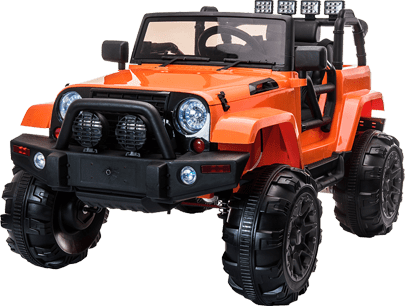- Home
- Shop
- Forest Series
- Grassland Series
- Desert Series
- Contact
- Home
- Shop
- Forest Series
- Grassland Series
- Desert Series
- Contact

Bear Series





2 DRIVING MODES WITH RC
Kids manual operation and parent remote control. The off-road SUV for one kid only can be moved forward and backward with the in-car control by the pedal and steering wheel, or be overridden by parents via the 2.4GHz RC with 3 speeds.
SAFE AND SMOOTH RIDE
Structured by toughened kid-friendly plastic, the twin-motor kids vehicle built with 4 spring-suspension knobby wheels allows the little driver fastened by the safety harness to conquer different terrains with ease.
RIDE ON GIFT FOR KIDS
This fully operational 12V ride on electric truck designed with appealing LED lights, accessible magnet doors, and a realistic Wrangler style is a perfect gift for your toddlers (3-6 years old) to begin an outdoor adventure.


CHARACTERISTICS
The Chipmunk is a member of the family Mammalia, Rodentia and Sciuridae. It is also known as the Striped Squirrel, the Timber Tiger and the Mini-bear. The body length among most Chipmunks ranges from 5.5 to 6.3 inches and the tail length is 5 Inches. Chipmunks typically weigh about 0.02 pounds and live about 5 to 10 years. They have small but prominent ears which face forwards, and small eyes on the sides of their heads. Most wild Chipmunks are lively.


Lorem ipsum dolor sit amet, consectetur adipiscing elit. Ut elit tellus, luctus nec ullamcorper mattis, pulvinar dapibus leo.


CHARACTERISTICS

RANGE AND HABITAT

DIET

BEHAVIOR
For the most part, adult Black Bears lead solitary lives, except when the mating season takes place. The mating season of Black Bears occurs during the summer, but the embryos do not begin to develop until the mother bear enters her den. Cubs are born in the middle of the winter denning period, usually between mid-January and early February.
Cubs are born tiny, helpless, and hairless, weighing less than half a pound. A mother bear will typically give birth to one to three cubs at a time. By the time a mother bear and her cubs are ready to emerge into spring, the cubs typically weigh around five pounds. The young bear grows very quickly and can weigh around 80 pounds on its first birthday. Cubs will remain with their mother for about 18 months or until she is ready to mate again.

The Chipmunk is a member of the family Mammalia, Rodentia and Sciuridae. It is also known as the Striped Squirrel, the Timber Tiger and the Mini-bear. The body length among most Chipmunks ranges from 5.5 to 6.3 inches and the tail length is 5 inches. Chipmunks typically weigh about 0.02 pounds and live about 5 to 10 years. They have small but prominent ears which face forwards, small eyes on the sides of their heads. Most wild Chipmunks are lively.
The Red Squirrel, a member of the Sciuridae, is an arboreal, omnivorous rodent often referred to as a Forest Seeder and folklore as the Devil King Squirrel.
The Arizona Gray Squirrel, also known as the American Gray Squirrel, is a member of the family Rodentia and Sciuridae. It is small in size, with gray fur and a belly between white and cream. It has long ears, no tufts of fur and a fluffy tail edged in white. The body is about 16-20 inches long and weighs up to 1.4 pounds.
The Rock Squirrel, also known as Sao Maozi or Stone Mouse, belongs to the rodent and is a species in the family Sciuridae. The most common natural predators of the Rock Squirrel include bobcats, owls, eagles and snakes. Though the Rock Squirrel is cute, alert, and courageous, it is still considered a pest due to its habit of destroying crops.
The Abert’s Squirrel is a member of the genus Sciurus with a body length of 18-22.8 inches, a tail length of 7.5-9.8 inches and a weight of 2.2 pounds, and can live up to 10 years in the wild. Its most distinctive feature is tassels of fur about 0.8-1.2 inches long at the tip of its ears, which looks very interesting. In addition, it is alert and agile.

Nerve-Racking Moment Black Bear Approaches Woman at Bus Stop Caught on Film
Unsettling footage of a black bear approaching a terrified woman at a bus stop in Canada has sparked renewed calls for people to be careful around bears.
According to a hashtag accompanying the clip, the footage was filmed in the Canadian province of British Columbia.
In the video, a black bear can be seen walking up to an unnamed woman sitting at what appears to be a bus stop. Though she edges slightly away from the bear as it begins sniffing at her, the woman makes no attempt to ward the animal away.
Instead, she is seen looking off-camera at someone nearby.
When encountering a black bear, the Humane Society of the United States states that it is essential to “remain calm and remember that the bear is likely more scared of you than you are of him.”
“Attacks by black bears on people are very rare and most black bears can be easily scared away,” they said. They recommend you “stand and face the bear directly” while making yourself look “as big as possible” by spreading your arms and legs or using a coat.



Follow Us: